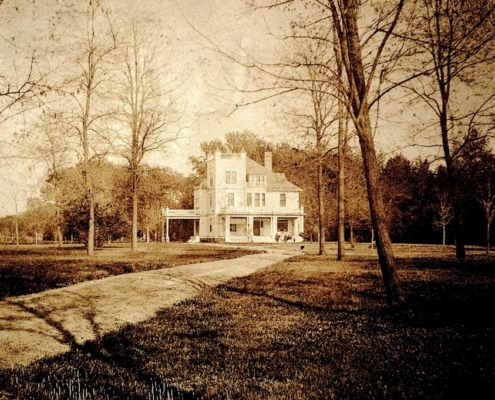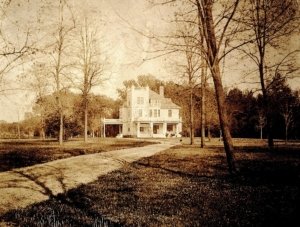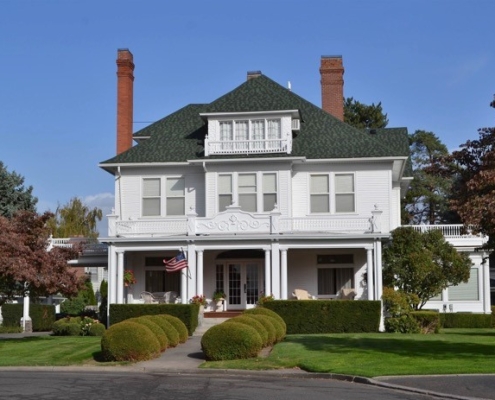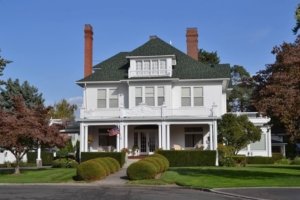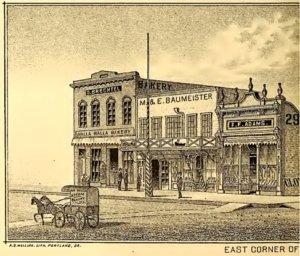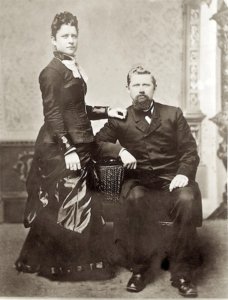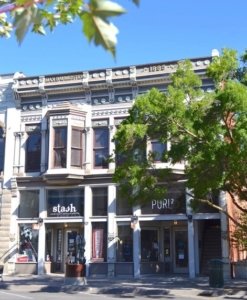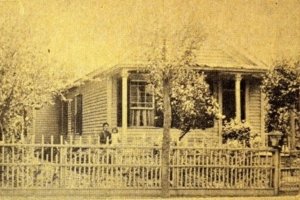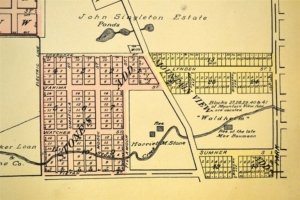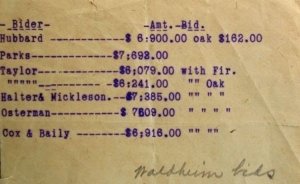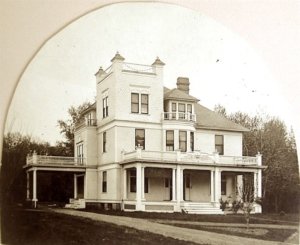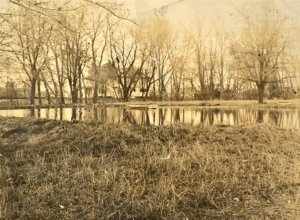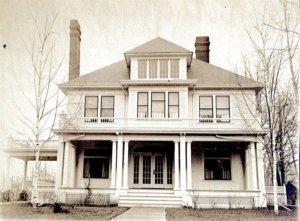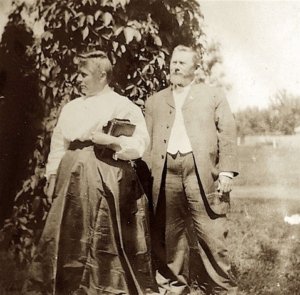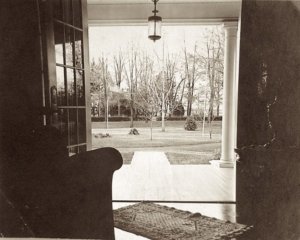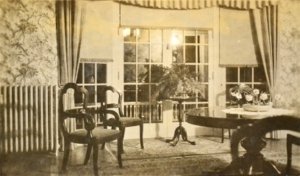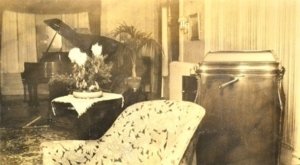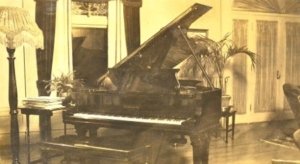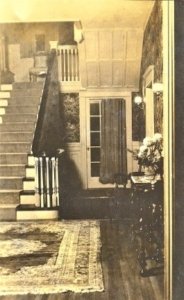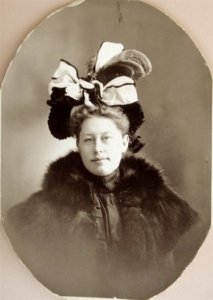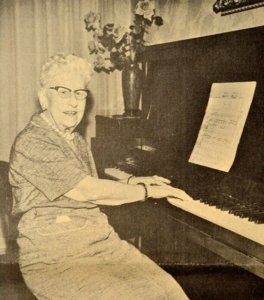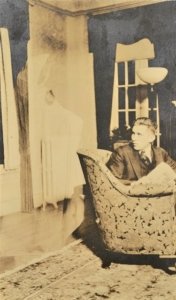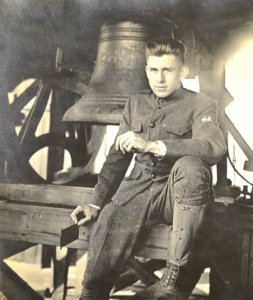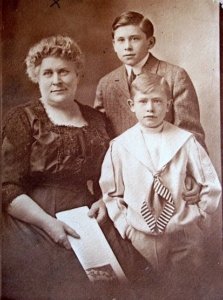Background
During the latter part of 1896, a large building – an imposing new house perhaps? – could be observed by passersby being built just east of South 2nd Avenue far outside the then-city limits. As work progressed, the structure began to assume an appearance somewhat castle-like. This structure was to become Waldheim, broadly translated as “home in the woods,” the new residence for German immigrant Maximilian Baumeister and his young wife, Alvine (pronounced Ahlveena).
Max Baumeister was born in Saxe-Weimar, Germany March 13, 1840, the son of a physician. When he was a young man the Baumeisters immigrated to the United States, settling in New York City where Max learned barbering. In 1859, aged 18, he left New York, sailing for Panama, crossing the isthmus on foot and by mule. Boarding a second ship, he sailed north to San Francisco where he disembarked, mining for a brief time before returning to New York. In 1861, Max headed west again, this time settling briefly in Portland, Oregon, but soon left Portland via steamboat headed for Wallula, W.T. From there, he walked the remaining distance to Walla Walla, reportedly with but $15.00 to his name. 1
With little work in Walla Walla, and a limited English vocabulary, Baumeister opened a barbershop on Main Street. At some point he was joined by his brother Edward (Ned), and ca. 1870 the brothers erected a two-story wood building on West Main Street between 2nd and 3rd. Their establishment, by that time advertised by the tony name, “Oriental Hair Dressing and Bathing Saloon, Baumeister Bros., Prop’rs,” occupied the right half of the street level, Jacob Coulter’s hardware store the left half, and upstairs housed the Walla Walla Union. Max and Edward worked long hours, six days per week. (Edward later settled in Asotin, where he was referred to as the “father of Asotin County.”)
Max Baumeister married Miss Anna Hauer in Walla Walla in 1869. One daughter, Augusta, was born of this marriage; Augusta later married Walla Walla brewer Jacob Betz. Anna travelled to San Francisco in July 1879 to seek medical advice for an unspecified illness and died there August 1st. The following year Max returned to New York where he was reacquainted with Miss Alvine Schweiker, who was a child when he had last seen her. Alvine was born on Long Island September 29, 1863, but her name and that of her parents, Gottlieb and Maria Schweiker, affirms her German heritage. At age 40, Max and Alvine, age 17, were married in Walla Walla February 11, 1880. The following day Max became a naturalized citizen of the United States. Over time he and Alvine had five children: Charlotte Anna, the oldest; Alvin; Max E.; Olga S.; Werner Waldermar; and the youngest, Karl Edward.
Not inclined to torpidity, Baumeister was soon immersed in a variety of undertakings, and in 1883 the brothers sold their tonsorial establishment, perhaps to allow Max an opportunity to explore new endeavors. He was active in the Republican party; a charter member of the Enterprise Lodge, I.O.O.F.; and Pioneer Society of Walla Walla. He joined the Masons. On January 1, 1909, with E. S. Isaacs, John Smith, Samuel Drumheller and Gilbert Hunt, Max filed articles of incorporation creating the Oregon-Washington Light & Power Company, to build and operate railroads, electric lines, street railways (a particular interest of Max’s), boats, ships and wharves in Washington, Oregon and Idaho. He maintained an office in the Baker-Boyer Building. The lion’s share of his fortune, no doubt, was ultimately gleaned through his real estate and insurance involvement.
Perhaps one of the Baumeisters’ more interesting involvements was that Max and Alvine were charter members of the First Church of Christ, Scientist of Walla Walla, incorporated January 7, 1901. Whether Max had been raised in the German Lutheran or Roman Catholic religion is unknown, but Alvine’s parents were driven from the Catholic Church by an inept priest and became Protestants. In a letter of June 18, 1981 to the owners of Waldheim from Dr. Werner Waldemar Baumeister, then a chiropractor in California, he wrote that his father, after suffering a medically incurable affliction, read Christian Science founder Mary Baker Eddy’s book Science and Health with Key to the Scriptures and was healed. 2 Max was elected church treasurer and trustee; Alvine was elected vice president. Their oldest daughter Charlotte, a trained singer, in time became the soloist at the church, and later still a Christian Science practitioner. Werner Waldemar Baumeister recalled that he and his sister Charlotte would bicycle to Christian Scientist services in the former Cumberland Presbyterian Church on the corner of 3rd and Alder. Prior to that time, services were held upstairs in the new (1889) Baumeister Building that had been constructed on the site of the earlier wooden building. 3
Early city directories note that Max and his brother lived above their shop. After Max’s marriage the Baumeisters resided in a five-room house at 10 East Alder Street east of the Denny Building, later the site of Lutton’s Pharmacy; the house was moved at some point to 134 Dr. Newell Street. In 1917, the Baumeisters, long since living in Waldheim, it was moved again to a lot on Willard Street near the county fairgrounds.
Max and Alvine Baumeister eventually acquired over 5,000 acres of wheatland in Garfield County. The Baumeisters sold this land and on January 25, 1883 purchased 213½ acres south of the Walla Walla city limits from Benjamin (B. F.) Stone, an early settler in Walla Walla and the father of Ben G. Stone who built the house at 1415 Modoc Street in 1909, often referred to as the “Frank Lloyd Wright house.” 4 A search of the deeds to this property disclosed that the Baumeisters were not the only original owners of the 213½ acres; grantees also included David W. and Ellen Small, Ira F. and Alice Small, Edward (Ned) Baumeister and E. D. Chapman. The land on which the Baumeister property is located was surveyed, divided into building lots, and filed on April 28, 1883 as Mountain View Addition to the City of Walla Walla.
On July 7, 1886, the Smalls, by warranty deed, sold portions of their property with water rights in perpetuity to the Baumeister brothers. It was not until April 3, 1900 that the next warranty deed was filed, by then Waldheim being occupied, when Edward and Elizabeth Baumeister sold their land bounded by Blocks 27 to 29 to 40 to 41 to the place of beginning for one dollar to Alvine Baumeister.
Construction of Waldheim
The architect of Waldheim is considered to have been Henry Osterman, although there appears to be no recorded documentation of that fact. Osterman was born in Essen, Germany in 1862. He received training as an architect in Dusseldorf, although documentation of what that involved does not exist. Osterman and three brothers immigrated to the United States in 1889, settling in Walla Walla where they worked as carpenters. By 1896 all three brothers had returned to Germany; Henry was by then advertising himself as a general contractor. Not licensed by the State of Washington as an architect until 1919, the year the state began issuing licenses, he hung out his shingle as an architect in 1899. As fellow Germans living in Walla Walla, it is not beyond speculation that Henry Osterman and the Baumeisters became acquainted. With six children at home, possibly a seventh from Max’s first marriage, the Baumeisters no doubt needed a larger house than the one on Newell Street, and their financial circumstances could bear the financial burden.
Although the exact date is missing, a bid sheet from the year 1896 to construct Waldheim exists. A total of seven bids from six different contractors were submitted. Of those seven, only one was higher than Osterman’s; nonetheless Henry Osterman was awarded the contract to build Waldheim, supporting the probability of a friendship between Osterman and the Baumeisters.
It is recorded in various sources that Alvine Baumeister worked with Osterman, specifying what she wanted for her new house. A recent discovery of Alvine’s obituary (she died October 11, 1937, aged 74) stated that during her girlhood she aspired to be an architect. Thus, the design for Waldheim was undoubtedly a collaboration between Alvine’s basic understanding of architecture and Henry Osterman’s ability to put her ideas into a working set of plans, making him the de facto architect of Waldheim.
Gradually the Baumeister holdings in Mountain View Addition consisted of 90 acres with 75 varieties of pine, spruce and other trees, but by 1896 when construction of Waldheim likely began it was surrounded by 13 acres.
The completed house stood two and one-half stories with a full-width front porch and a shingled, full-height square tower at the northwest corner, that was thought to give the house a Rhenish or Rhineland look, reminiscent of castles along the Rhine River. In that the house was essentially of Colonial Revival design, the tower, somewhat clumsily distinctive, could be thought of as a quizzical ornament, an architectural folly. 5 Although lacking a crenelated parapet, the pyramid-capped projections or merlons at the tower’s four corners probably were meant to insinuate a battlemented parapet; however, the delicate Eastlake-derived, lathe-turned ornament between these projections could have been shattered by a single volley from a Ping-Pong ball! 6
Except for the asymmetrically-placed tower, the main façade was otherwise centrally massed. The house had a hipped roof with dormer projections. The entrance was centered on the wide porch, approached by five steps. Originally the porch did not have a railing. It was supported primarily by four square posts, assisted by ten simple round columns. At the second level the porch was surrounded by an ornamental balustrade, the section directly above the main entrance embellished with a type of pseudo-della Robbia ornament. A three-sided bay was located on the second level, surmounted by an ornamental balustrade. The north side of the house had a secondary entrance accessed from a porte-cochère that was surmounted by a balustrade matching the others on the house, and at the attic level was a projecting gable with a similar ornamental balustrade. Other than the shingled siding of the tower projection, the balance of the house was clapboards. All windows were double-hung. Floors on the main level were oak, those of the upper floors were less expensive fir. There were eight fireplaces throughout the house. The third floor, originally probably only partially finished, measured 63 by 40 feet and was paneled in cedar shiplap. Walls of the main and second floor were reportedly plaster laid over canvas. In that plaster was always applied over lathes to secure it, the use of canvas is perplexing. Woodwork throughout the house, and most likely including the porches, was by Whitehouse-Crimmins. The total cost of construction, that is reported to have taken three years, was $7,609. The property also contained a barn southeast of the house and an Alpine style summerhouse. A lake that was created by damming Stone Creek was used for boating.
It is recorded that the Baumeister family occupied their new house in 1900, but they were not listed until the 1902 Walla Walla City Directory as living at Waldheim. 7 The original address for the house was on South 2nd. At some point Edwards Drive was cut through the property that curved between 2nd and Stone Street, and the address was known as 106 Edwards Drive. The current official address is 124 Stone Street although the front of the house faces Edwards Drive.
A long drive wound its way from South 2nd to the port-cochère. A description of the original layout of the interior does not exist, but from what could be gathered from various sources there was an entrance hallway that would also have been accessible also from the porte-cochère side entrance, a living room, dining room, apparently a music room, kitchen and pantry. On the second level were five bedrooms and one bathroom. The original wallpaper for the house was from Schumacher in New York. Steam radiators supplied heat.
Max Baumeister enjoyed living in Waldheim less than a decade. Suffering from diabetes, he died February 3, 1909. A Christian Science Service was held at Waldheim on February 5th, followed by a Masonic burial at Mountain View Cemetery. At the time of his death Baumeister’s estate was estimated at $160,000, left to his widow to be held in trust for their children.
In 1914, Alvine Baumeister decided to have some changes made to Waldheim. It has been speculated that perhaps she was not in complete agreement about the appearance of the “castle” tower on the northwest corner of the house and found it disagreeable. She had it removed, providing space to widen the third-level dormer as well as enhancing the symmetry of the main façade that had been so off-balanced by the tower. She also had the 45° sides of the projecting bay at the second level tucked in to form 90° angles. The della Robbia-like ornament directly above the front steps was removed and replaced with balusters to match those of the rest of the balustrade atop the porch. The balance of her changes were made to the interior. What they might have involved is speculative in that no interior photos of the house taken before 1914 have been located. Total cost of modifications to the house was $1,400. Alvine resided at Waldheim until her death October 11, 1937. Charlotte Baumeister Thompson was Executrix of the Last Will & Testament of her mother. 8 As early as 1920 Alvine had begun selling off portions of the vast property that surrounded the mansion. Between 1938 and 1944 a series of contracts for deed and quit claim deeds were filed by the various Baumeister children. City directories were not published annually during WWII. Max E. Baumeister, like his older brother Werner, was a chiropractor and lived in Waldheim as late as 1941. From existing deeds, it appears that by 1943 Waldheim and all property held by the Baumeisters in Mountain View Addition had passed out of their ownership.
A list of all owners of Waldheim over the following years is not germane to this history. However, two prominent owners are notable. In the 1970s, Dick and Sue Wright, purchased the house and made numerous changes, restoring parts of the house that were by then in deteriorated condition. The living room was enlarged, apparently by incorporating the music room and entrance hall. A sun porch was built on the south side of the house and a large, enclosed swimming pool to the rear of the house, reached by a covered walkway from the kitchen. Current owners, Roger and Julia Russell, have continued making modifications to the interior, including converting the 2,600 square foot third floor attic to a family room, bar and children’s room. The five bedrooms on the second floor were reduced to four with new master bath. A deck was built over the sunroom.
Denouement
Waldheim is indisputably an impressive house. Its Colonial Revival architecture is restrained, less conspicuous in abundance than most of the other Colonial Revival mansions in Walla Walla, but the sheer size of the house is quite majestic. When new, it must have presented a magnificent apparition to passersby, sitting on its multiple acres. Even now, surrounded by smaller and much newer houses, it positively captures the eye. Its rich history along with its graceful lines render it an important structure in Walla Walla.
A Photographic Reflection of Waldheim and Some of Its Residents
All following photos are from the Baumeister box or the Waldheim folder at Northwest and Whitman College Archives or are courtesy of Joe Drazan.
Notes on the Baumeister Family
Charlotte Baumeister was a talented singer and pianist. She made her debut at Small’s Opera House when she was but five years old in the rôle of a baby in a cradle. In later years she reported that the management was displeased with her “performance” because she continually kept popping her head up out of the cradle. Despite a bad review for her debut, Charlotte continued singing locally. As mentioned in the text, she was soloist at the First Church of Christ, Scientist. She attended the Whitman Conservatory of Music that accepted children from the town at the time, as well as Whitman students. In 1901, Charlotte visited relatives in the East, and a teacher in New York was found for her, Mrs. Eno Wadsworth-Vivian. Her parents consented to her studying with Mrs. Wadsworth-Vivian, and Charlotte lived with her teacher at 5th Avenue and 11th Street. A newspaper article on July 16, 1904 noted, “An informal musicale was given the previous evening at the suburban residence of Mr. and Mrs. Max Baumeister by their daughter Miss Charlotte Baumeister, who recently returned from New York, where she has been pursuing her musical studies… There were a large number of invited guests present, who were highly entertained…” On March 6, 1910, it was reported that the Walla Walla Symphony “will be assisted by Mrs. Charlotte Baumeister Thompson, soprano – who will sing an aria from Oratorio [which oratorio was omitted, possibly one by Handel] and a group of songs. Mrs. Thompson is a native of Walla Walla and began her musical study here, continuing the work under some of the best masters of New York.” In fact, during its first 25 years 29 singers were soloists with the Walla Walla Symphony, Charlotte Baumeister Thompson holding the record of seven performances.
Werner Waldemar Baumeister may have been the most outré of the Baumeister children, perhaps due to his mother’s choice of such an extraordinary name for her firstborn son. He took photos using a remote-controlled magnesium flash. His memoirs and letters are filled with eccentric ideas conveyed in uniquely expressive language. As an adult he was a chiropractor in San Mateo, California.
Footnotes
- In a letter of March 16, 1979 Dr. Werner Waldemar Baumeister wrote that his father left Germany at age 15 in order to avoid any possibility of being drafted into the impending war against Austria-Hungary. Naturalized in 1861, this made him eligible for the draft into the Civil War that was declared April 12, 1861, hence his rapid departure for California.
- The history of Christian Science in Walla Walla was researched by the author in 2019 and may be accessed on the Walla Walla 2020 website, ww2020.org or at Whitman College Archives.
- Werner was Max’s and Alvine’s child with undoubtedly the most unusual name, that he later explained in his memoirs, stating that he was named for the Romantic hero of a Russian novel that his mother read while pregnant with him.
- The Modoc house was researched by the author in 2019 and may be accessed on the Walla Walla 2020 website, ww2020.org or at Whitman College Archives.
- Following the death of Max in 1909, Alvine Baumeister had the tower removed. One could surmise that she was not fully supportive of her late husband’s wish to have a German castle.
- Sir Charles Eastlake’s 1872 book, Hints On Household Taste In Furniture, Upholstery and Other Details, was the nonpareil in influencing late Victorian taste for exceedingly overwrought fashion.
- There was no directory printed in 1901; the 1900 directory covered both years and bears a printing date of 1900, so it is likely correct that the Baumeisters moved into Waldheim in 1900.
- Charlotte Baumeister and Frank B. Thompson were married at Waldheim October 11, 1905. Thompson was a prominent Walla Walla businessman who, at the time of his marriage, was employed at the Gilbert Hunt Company. Gilbert Hunt and his wife were, along with Max and Alvine Baumeister, founders of the First Church of Christ, Scientist in Walla Walla, and may well have introduced Charlotte and Frank. In 1910, Frank Thompson and A. C. Crecilius purchased The Book Nook in Die Brucke Building, he and Charlotte operating the business for 23 years.
Resources
- TitleOne (formerly Pioneer Title & Escrow)
- Dana Bronson, Northwest and Whitman College Archives
- Walla Walla Public Library
- Walla Walla County Auditor
- Cindy Fazio, Cadastral GIS Technician, Walla Walla County Assessor’s Office
- Lyman, Prof. W. D., Lyman’s History of Old Walla Walla County, Vol. II, The S. J. Clarke Publishing Company, Chicago, 1918
- Gilbert, Frank T., Historic Sketches of Walla Walla, Whitman, Columbia & Garfield Co’s. W.T. Also Umatilla Co. Or., A. G. Walling,, Portland, 1882
- McDonald, Lucile and Werner Lenggenhager, Where Washingtonians Lived, Superior Publishing, Seattle, 1969
- Bennett, Robert A., Walla Walla: Portrait of a Western Town 1804-1899, Pioneer Press Books, Walla Walla, 1980
- Bennett, Robert A., Walla Walla: A Town Built to be a City, 1900-1919, Pioneer Press Books, Walla Walla, 1982
- Andres, Penny, Walla Walla: Her Historic Homes, Vol. I, 1991
- Schultz, Dan, A Dream Fulfilled: 100 Years of the Walla Walla Symphony Orchestra, 1907-2007, Walla Walla Symphony, 2006
- Walla Walla Union-Bulletin Lifestyles, July 2007; April 11, 1976; and November 3, 1974
- Baumeister, Dr. Werner Waldemar, various correspondence
- Susan Monahan, Walla Walla Historian
- Plat Map of Mountain View Addition to the City of Walla Walla, W.T.
- Standard Atlas of Walla Walla County, Washington Including a Plat Book of the Villages, Cities and Townships of the County, George A. Ogle & Co., Chicago, 1909
- Various unidentified newspaper articles from 11/7/1909, 3/14/1917

